PinotFile: 7.8 December 29, 2008
|
The Boys of John Ash & Co.
 The Santa Rosa restaurant, John Ash & Co., has played a little known but remarkably important role in the history of Sonoma County Pinot Noir. John Ash & Co. was known for spawning numerous innovative and progressive wine trends that have since become commonplace in restaurants today. Wine-by-the-glass-service was prominently featured at John Ash & Co., and organized blind tastings of wines and creatively themed wine dinners emphasizing food and wine pairings were first popularized at the restaurant. John Ash & Co. was among the first restaurants to have a wine bar and an associated retail wine store. The early culture of wine and food pairing flourished here as wine began to take its rightful place on the American table both as a compliment to food and a star in its own right. There was an emphasis on seasonality in the creative menus that featured fresh foods from local artisans, farmers and fishers. Over the years, numerous ex-employees of the restaurant went on to become successful winemakers, winegrowers and key employees in various wine related businesses. I interviewed winemaker, wine consultant and wine writer, Don Baumhefner, who was intimately involved with John Ash & Co. from its beginnings, and Dan Kosta, a former Wine Director at John Ash & Co. and current winery owner, both of whom fondly recalled the many years spent working at the restaurant. In addition, I attended cooking classes offered by John Ash, where I listened and spoke with him about his life story. I have pieced together the trio’s comments to trace the history of this Sonoma County institution.
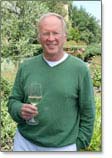 The story begins with John T. Ash. Growing up in Colorado, John’s first food exposure to food was observing the cooking talents of his grandmother. Despite the impression she made on him, he did not initially consider a career as a chef, instead attending college and obtaining a degree in fine arts. After graduation, he was employed in New York developing new food products for Del Monte Foods. A fortuitous opportunity in Del Monte Foods’ marketing division brought him to San Francisco. His proximity to Sonoma County allowed him the freedom to explore the emerging food culture and the artisan food suppliers there during the 1970s and it wasn’t long before he fell in love with the lifestyle of the region. Venturing to Europe, John attended cooking schools in both London and Paris and worked in Burgundy for over a year as a kitchen slave. John recalls, “My goal initially was not to be a chef, but to emerge myself in the culture.” His experience in France taught him what was to become the basis of his life long cooking philosophy: fresh, local and seasonal. He was enamored with the French chefs’ daily routine of never creating a menu until a trip was made to the market in the morning. By the time he returned to the states, he was a committed chef and began work in San Francisco before an opportunity brought him to Sonoma County. In 1976, Don and Kay Baumhefner lived in the tiny town of Forestville, located in western Sonoma County and the home of Russian River Vineyards where Don worked. Russian River Vineyards had been founded by Robert Lasdin in 1963. By 1975, financial pressures forced Lasdin to sell the winery and 10 acres of vineyards. The subsequent owner attempted to revive the outdated restaurant, winery and vineyards on the property. He approached the Baumhefners, suggesting that Kay, who was a chef, take over the restaurant and Don, who was an inexperienced winemaker, revive the winery. About the same time, Merry Edwards, a winemaker and former colleague of Don’s at University of California Berkeley, was considering a move to Sonoma County. At a New Year’s Eve dinner party at the end of 1975 at Mt. Eden Winery in the Santa Cruz Mountains, the Baumhefners celebrated with Merry Edwards (who had been the winemaker at Mt. Eden since 1974), her husband Bill, winemakers Joseph Swan, David Bruce and others. As a result of discussions that night, Merry Edwards agreed to become the winemaker at Russian River Vineyards with Don acting as an assistant. A search was then conducted for a prominent chef and both John Ash and Mark Miller were interviewed. Don and Kay decided to hire John because Don says, “He had a neat carrot made out of dough on his lapel at the interview.” As luck would have it, John’s spouse crafted Christmas ornaments from dough and the lapel ornament was her idea. Mark Miller of course, went on to become a nationally recognized authority on southwest cuisine. The team that was assembled at Russian River Vineyards was clearly a recipe for success. The restaurant opened to much acclaim, featuring Sonoma County wines served by the glass, and featuring innovative California wine country cuisine that enticed many San Franciscans to make an hour journey to the restaurant. Sadly, the proprietor was dishonest and the operation failed after a few weeks when the owner failed to pay all of those involved. John Ash and Kay Baumhefner moved on to the Bodega Harbor Country Club, where John would cook, Kay would help in the kitchen during the day, and then change clothes to receive customers in the evening. Don meanwhile was teaching at a Montessori school and knew the children of Sandra Steiner (now Sandra McKeever). She was looking for a winemaker and Don recommended Merry Edwards. Don advised Sandra to send Merry abroad to learn winemaking and she did. Upon Merry’s return, Matanzas Creek Winery was born. The success of Matanzas Creek Winery launched Merry Edwards and the winery into national prominence. In time, she left Matanzas Creek to devote herself to producing Pinot Noir, assuming the nom de plume “Queen of Pinot” and eventually founding her critically acclaimed namesake winery, Merry Edwards Wines, in the Russian River Valley. John Ash had a desire to have his own restaurant which led him in 1980 to Santa Rosa, where he recruited several doctor investors, gutted an old Chinese restaurant in Montgomery Village Shopping Center, and founded John Ash & Co.. The phone number was 527-SOUP (7687), named in honor of the former Chinese restaurant at the site, and still the phone number of John Ash & Co. to this day. The wine program at John Ash & Co. that was developed by wine manager Don Baumhefner is considered passé today, but was a first for California in 1980. The philosophy was to give the customer the opportunity to taste many different wines. Twelve wines were offered by taste (2 ounces) and by the glass (6 ounces) ranging in price from $1.75 to a $3.25. Examples of wines sold by the glass included 1981 Kenwood Chenin Blanc ($1.95), 1980 Charles F. Shaw Beaujolais (yes, that Charles Shaw, now with new owners and known as “Two Buck Chuck,” $1.95), 1980 Sausal Chardonnay ($2.50), 1979 Chateau Rieussec ($1.95 a half glass), and St. Francis Chardonnay ($3.25). In addition, patrons were offered the opportunity to buy any wine from the restaurant’s wine store at the retail price plus a $2.00 corkage fee (later raised to $3.00). An early example of the Pinot Noir stock list is on page 3. Don Baumhefner (left) is pictured with the author at Martin Ray Winery.
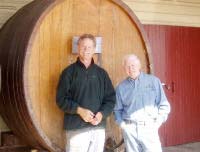 Weekly tastings of wines, usually organized by variety, were highly popular and sometimes as many as eighty people were in attendance. The price, $8.00 for “Big Zinfandels” to $40.00 for Grand Champagnes, was attractive and included at least eight wines with “kitchen treats to accompany the wines.” The theme for the inaugural wine tasting at John Ash & Co. was 1977 Pinot Noirs. Billed as, “The finest collection of California Pinot Noirs ever assembled,” the producers included Joseph Swan, Firestone Reserve, Kenwood Jack London Vineyards, Chalone Young Vines, Chalone, Carneros Creek and Santa Cruz Mountains Vineyards. A copy of a partial listing of the restaurant’s inaugural wine tasting schedule is on page 4.
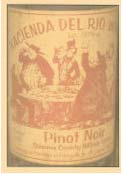 In 1980, there were only a handful of commendable producers of Pinot Noir in California. It was a time of experimentation and winemakers were eager to try most anything to master this fickle grape. Don refers to the time as, “An age of innocence, everything was young, fresh and new.” No one really knew of or concerned themselves with clones at the time. Tom Dehlinger had made his first vintage of Pinot Noir at Joe Swan’s winery in 1975. Joel Peterson crafted his first wine at Swan’s winery as well in 1976. Joe Swan and Ken Burnap of Santa Cruz Mountains Vineyards would travel annually with Kermit Lynch to Burgundy to learn new methods of vinifying Pinot Noir. With Lynch translating for the trio, they were welcomed into all the great cellars and the French freely shared their secrets. By the early 1980s, Burt Williams and Ed Selyem had teamed up. Ed approached Don, asking him to sample a Pinot Noir labeled Hacienda Del Rio from the 1978 vintage produced from Rochioli old block Pinot Noir grapes. Don thought it was very tasty and bought ten cases at $10 a bottle. Of course, Don now says, “I regret not buying at least ten cases every year!” Burt and Ed had to abandon the Hacienda Del Rio name over a trademark dispute, and renamed their winery Williams Selyem.
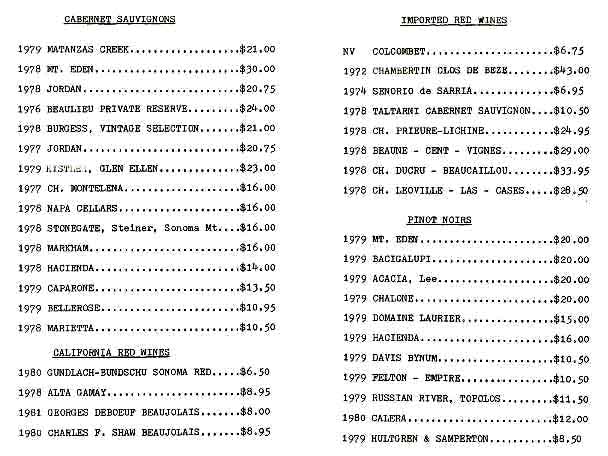 Special wine dinners were part of the wine program from the beginning at John Ash & Co.. In 1981, the second wine dinner was organized to honor Merry Edwards. Don noted in his newsletter, “While most of you know that Merry produced what by consensus must be considered the best 1978 Chardonnay made in California, many of you may not be familiar with her accomplishments while at Mt. Eden. In 1974, she produced one of the very best Cabernet Sauvignons of that renowned vintage. In 1975, she crafted not only the best California Chardonnay Don has ever tasted, but also the best California sparkling wine he has ever sipped. In 1976, she produced the only Zinfandel that Don has ever ranked above a Joseph Swan Zinfandel.” The menu for the dinner was drawn from recipes of a talented women whom John Ash admired, Simone Beck, best known for her authorship with Julia Child of the Mastering The Art of French Cooking books. The dinner wines chosen included a never released 1979 Matanzas Creek sparkling wine and a 1975 Mt. Eden Pinot Noir, called by wine critic Robert Finigan at the time, “His favorite California Pinot Noir.”
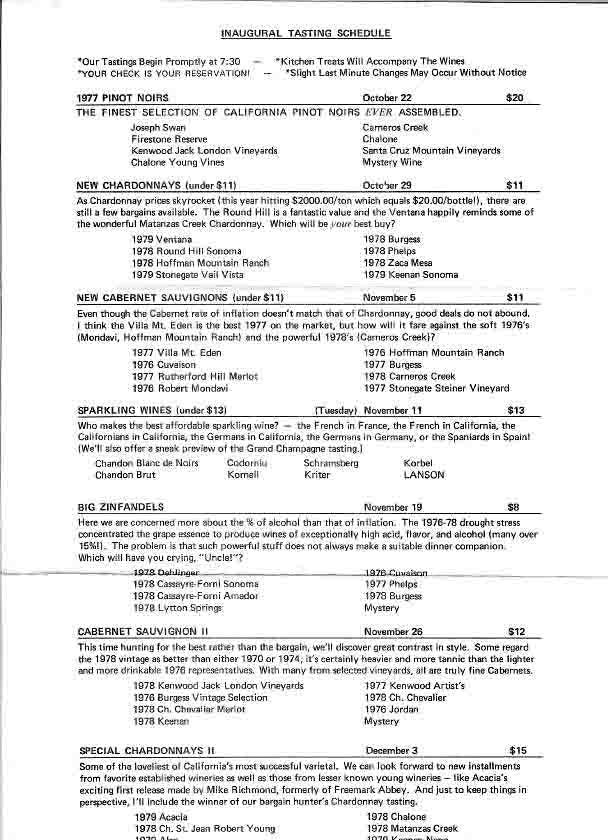 The early years of John Ash & Co. coincided with a wondrous period for wine enthusiasts because of the plethora of inexpensive good wine available. Top premier cru Burgundies of the 1970s by Dujac and Grivot could be had for $10 to $15 a bottle. When Don talks about those days, his gaze drifts off and he begins mumbling, “Those were wonderful times.” At John Ash & Co., marvelous wine dinners featuring the 1959, 1961 and 1962 vintages were offered at $125 dollars per person. The 1959 French dinner lineup included 1961 Gosset Brut Integral Millesime Ancien, 1972 Domaine de la Romanee-Conti Le Montrachet, 1959 Chateau Pontet-Canet, 1959 Carruades de Lafite, 1959 Domaine de la Romanee-Conti La Tache and 1959 Chateau Suduiraut. As the consulting wine list creator at John Ash & Co., Don had to meet frequently with wine representatives. These sessions would be scheduled on a single day from 10:00 AM to 4:00 PM with each wine salesperson allocated fifteen minutes to show their wares to Don. Don recalls when Steve Bixler of Kistler Vineyards came in to the restaurant. Kistler required a purchase of 10 to 15 cases of wine, an unheard of demand at the time. The wine was expensive to boot. Don acquiesced and John Ash & Co. became the first commercial account for Kistler, now one of Sonoma County’s most prestigious producers of Chardonnay and Pinot Noir. While Don was managing the wine program at John Ash & Co., his wife worked with noted Sonoma chef Lisa Hemingway to create the pastries for the restaurant. Hemingway would eventually move on and open her own Santa Rosa restaurant. Kay later became the chef at Della Fattoria Restaurant in Petaluma and now teaches food classes out of her home. Don left John Ash & Co. in late 1982 to manage a wine bar in San Francisco. He continued to consult for John Ash & Co. and also worked as the assistant winemaker at Joseph Swan Vineyards. Don reminisces about the challenges of setting up Joe Swan’s winery accounting on one of the first Apple computers. Don worked closely with Joe Swan for many years until Joe’s passing while continuing to consult for John Ash & Co.. He later became the winemaker at Copeland Creek in the Sonoma Coast and today is the winemaker at Ridgeway Vineyards in Petaluma. By the mid 1980s, the cuisine at John Ash & Co. had become innovative for the time and in conjunction with the unique wine program, brought notoriety to the restaurant. The attempt to sell wine retail at the restaurant wine bar never really took off, but the restaurant was a clear success in all other respects. In 1985, John Ash was chosen as one of America’s “Hot New Chefs” by Food & Wine magazine. In 1987, the Vintner’s Inn was built in Santa Rosa at 4350 Barnes Road, just off River Road, by retired scientist John Duffy. His desire to add a top name restaurant to the Inn attracted him to the accolades that John Ash & Co. had received and he induced the restaurant to move to its current location adjacent the Inn. Between 1987 and 1990, John Ash also consulted on Fetzer’s wine and food program in Hopland, California. Building on his experience and influenced by others such as Zelma Long at Simi, who was an early proponent of pairing wine and food, John Ash became widely respected as the originator and teacher of wine country cuisine.
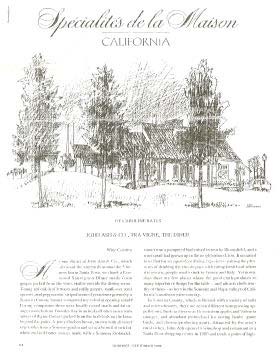 A sparkling review of John Ash & Co., written by Caroline Bates, appeared in Gourmet magazine in September, 1988. Paraphrasing Bates, she said, “Sonoma County, southern France and Japan are the main currents in Ash’s cooking. Ash’s plates are artistic, featuring sprays of flowers and sauces that look like brush strokes. Throughout the year Ash uses as many as seven edible flowers in his cooking. There are few places where the good earth produces so many superlative things for the table - and attracts chefs worthy of them - as here in the Sonoma and Napa valleys of California’s northern wine country.” She pointed out that the wine list was composed primarily of local Sonoma County producers, some of which were within walking distance of the restaurant, and noted that John Ash & Co. was one of the first restaurants in the United States to pay special attention to after-dinner wines. Dan Kosta began working at John Ash & Co. in 1990. His father, Tom Kosta, was in partnership with Steve Lorenzon and Tom Bolger in a retail wine store in the Railroad Square area of downtown Santa Rosa. They were competitors of John Ash & Co. when the restaurant was located in Montgomery Village. Growing up, Dan was exposed to wine with every meal and developed an appreciation for and interest in wine at an early age. At age 18, he joined the staff at John Ash & Co. as a bus boy. From the start, he became immersed in the wine and food culture that was prevalent among the staff at the restaurant. As Dan puts it, “Ash was a petri dish for learning about fine wine and food.” He struck up a friendship with Michael Browne who had joined the staff. Michael recognized Dan’s talent and enthusiasm and suggested to him that he ask to be promoted. Dan quickly became a waiter, then was promoted to management, becoming the restaurant’s Wine Director at age 24. Age was not a deterrent to success at the restaurant and Dan thrived on the continuous on-the-job training. The restaurant’s wine budget was about $100,000 a year and over 500 wines were on the wine list, quite large for Sonoma at the time. Dan was able to taste most wines that were added to the list and learned to match John Ash’s cuisine with the wines. The staff traveled to many local wineries to taste as well. After work, wines, wineries, wine styles and wine and food pairings were discussed in depth by the staff, often until the early morning hours. Julia Child was a long time proponent of this type of experience, stating, “Knowledge of wines is a lifetime hobby, and the only way to learn is to start drinking and enjoying them and comparing types, vintages, and good marriages of certain wines with certain foods.” In the mid-1990s, the staff added a large number of Pinot Noirs to the wine listed based on the wine’s acknowledged affinity with food and the compatibility of Ash’s cuisine with Pinot Noir. Sales were slow, however, unless the wines were ‘hand-sold.’ Burgundies were often the safer choice for customers at the time because of their consistency, but the quality of Pinot Noir from Sonoma County was improving and more turned up on the wine list over time. By 1990, John Ash had become the full-time culinary director of Fetzer Vineyard’s Valley Oaks Food and Wine Center. He had become disenchanted with the daily grind of working in a restaurant kitchen and was happiest writing and talking about food. Dan was always impressed with Ash’s coolness in the kitchen where he displayed an unending patience with others. He treated his employees very well and never stopped encouraging their wine and food education. In the late 1990s, chef Jeffrey Madura joined the cooking staff at John Ash & Co.. As John Ash became more involved in outside projects, Madura was able to maintain the quality of the cooking at a high level. His cuisine took on more Mediterranean influence, more simplicity and emphasized grilling. In 1999, Duffy retired and the Vintner’s Inn and John Ash & Co. restaurant were sold to Don and Rhonda Carano of Ferrari-Carano Vineyards & Winery who continue as owners to this day. The current Executive Chef is Thomas Schmidt. The legacy of John Ash still lingers, remaining the popularization of fresh, seasonal and local wine country cuisine paired with wines from the region. A re-creation of the very first wine tasting held at John Ash & Co. was organized by Don Baumhefner in 2000. The Pinot Noirs from 1977 included ones by Joseph Swan, Chalone, Mt. Eden and Santa Cruz Mountains as well as two French burgundies. According to Don, “The California Pinot Noirs were still solid and it was a thrill for everyone in attendance to relive this tasting.” The announcement is below.
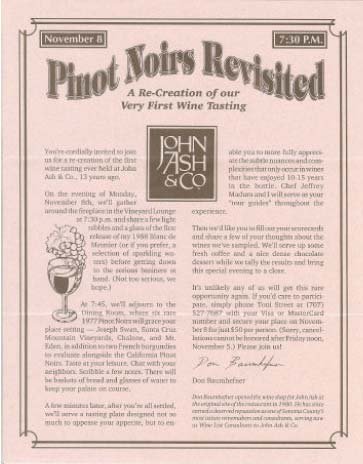 During the years that Dan Kosta worked at John Ash & Co., Michael Browne came and went as a waiter at the restaurant between breaks for schooling. The two developed a close and lasting friendship founded on their enthusiasm for fine food and wine. They also shared an admiration for the winemakers who frequented the restaurant. By 1996, Dan was the wine director at John Ash & Co. and Michael had begun seriously considering a career in winemaking. They talked about a winery partnership on numerous occasions and finally set their plan in action. Every night after work, both of them would put $10 in tip money into an envelope that Dan kept in his desk. After accumulating $1,300, they bought one half ton of Pinot Noir from a vineyard on Eastside Road in the Russian River Valley, an old hand cranked de-stemmer and crusher, old used barrels and crafted their first “garagiste” wine. Two years later, while still employed at John Ash & Co., the two launched Kosta Browne Winery with the inaugural release of a 1999 Sauvignon Blanc from Lake County, California. The bottles sported hand-drawn labels which remain identical today except for the color scheme.
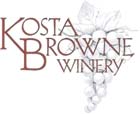 The first commercial Pinot Noir from Kosta Browne was produced in 2000 from grapes sourced from the Cohn Vineyard in the Russian River Valley. Michael had gained valuable experience working as a winemaker at Deerfield Ranch Winery in Sonoma Valley. The partners gradually acquired contracts with notable local vineyards including Amber Ridge, Kanzler and Koplen. Their initial goal was not to attempt to make or duplicate Burgundy, but rather to create a delicious Northern California artisan drink with as much flavor and intensity as possible. Despite their background, they did not have food and wine matching in mind when they created the Kosta Browne style of Pinot Noir. In spite of this, they have found over time that their wines perform beautifully at the table with appropriate foods. Michael and Dan (pictured on the left and right respectively) have the perfect business relationship with Michael handling the winemaking and Dan in charge of sales and marketing.
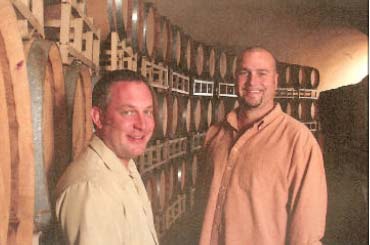 The list of other prominent alumni of John Ash & Co. is lengthy, but a few names should be highlighted. Matthew Gustafson worked as a wine buyer and sommelier at John Ash & Co., and later was the wine buyer for Oakville Grocery. He eventually became an accomplished winemaker for Dutton Estate Winery and his own label, Paul Matthew Winery. Steve Galvan, a former sommelier at John Ash & Co., is now the General Manager at Ramondin USA in Napa, which produces tin capsules for wine bottles. Paul Sloan is a third generation Sonoman who had his wine epiphany while working as a wine steward at John Ash & Co. During a tasting of very expensive white burgundies, he sampled his first Le Montrachet. His interest in Burgundy wines was ignited that day and along with encouragement from his wife, Kathryn McGrath-Sloan, who was also educated in wine, immersed himself in learning about wine. Together with Matthew Gustafson, he won the Greenwood Ridge California State Wine Tasting Championship in the Professional Division. He enrolled in the viticulture program at Santa Rosa Junior College and obtained practical experience under the guidance of famed viticulturist Warren Dutton of Dutton Ranch in Sonoma County. Spurred on by the encouragement of Warren Dutton, Paul and his wife started Small Vines Viticulture in 1998, specializing in the planning, installation and precision viticulture of close-spaced vineyard estates in Sonoma County. His clients have included Paul Hobbs, Sonoma Coast Vineyards, DuMol and Red Car Wines. John Ash & Co. alumnus Markus Wilson is now the Key Account Specialist for Southern Wine & Spirits. In 2000, he placed second with partner Dan Kosta in the California Wine Tasting Championships Professional Division. Former Wine Director at John Ash & Co., Walter Inman, is currently working for Pacific Wine & Spirits. The most prominent alumnus of all, John Ash, continues to act as culinary director for Brown Forman wines (the current owners of Fetzer) and conduct cooking classes at his eponymous restaurant as well as other venues in Sonoma County. For a schedule of cooking classes at John Ash & Co., visit the Vintner’s Inn website at www.vintnersinn.com. Today, the restaurant has one of the finest wine lists in Sonoma County with approximately 600 wines from both local and far-reaching wineries. An Annual Pinot Family Reunion is held each June at the restaurant. A three-course family style dinner is paired with Pinot Noirs from over 50 of Northern California’s top Pinot Noir producers. Details are available on the Vintners Inn website. John Ash currently has three excellent books in print. Cooking One on One: Private Lessons in Simple Contemporary Food from a Master Teacher (2004) was the winner of the 2005 James Beard Foundation Award, From Earth to Table: John Ash’s Wine Country Cuisine (co-author Sid Goldstein, 2007) was nominated by both the James Beard Foundation and the International Association of Culinary Professionals as one of the best books of 1996, and American Game Cooking (co-author Sid Goldstein, 1991).
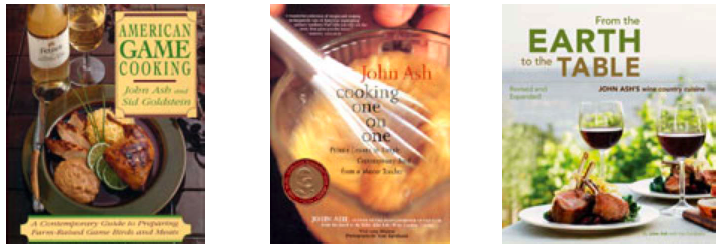 John is also a partner in the winery, Sauvignon Republic Cellars, headquartered in Santa Rosa. This unique winery offers Sauvignon Blanc from several sources including the Russian River Valley and Potter Valley, Stellenbosch (South Africa) and Marlborough (New Zealand). John is enamored with Sauvignon Blanc and says, “The bright, lemony flavors layered with exotic hints of tropical fruit make this wine a natural with almost any cuisine. It’s like adding a squeeze of ripe lemon and what food wouldn’t be enhanced by that?”
 John recently shared with me his current and concise view of matching food and wine. He believes that one can match any wine with any food by adjusting the six flavors of taste. The six tastes include sweet, sour, bitter, salt, pepper and umami (pronounced oo-mom-ee). Umami is the element of pleasure, an amino acid known as glutamate, which in its free form in foods creates the taste sensation described as delicious, tasty and savory. Examples of foods containing umami are MSG, mushrooms, soy sauce, and parmesan cheese. John decries that every recipe must have at least three of the tastes for proper flavor expression. By adjusting the combination of three or more tastes, the food can be matched to any wine of choice. The boys from John Ash & Co. including chefs John Ash and Jeffrey Madura, sommeliers Dan Kosta and Paul Sloan, and vintners such as Don Baumhefner, Michael Browne and Matthew Gustafson have educated our palate and enriched our love of wine and wine country cuisine. Fortunately, they continue to inspire and assist us in arriving at the ambrosial experience that comes from fresh food properly cooked and appropriately paired with savory wine at the dinner table. Listen to my podcast interview with Dan Kosta, discussing his experiences at John Ash & Co. and his later role in the founding of Kosta Browne, on Grape Radio at www.graperadio.com (after January 5, 2009). |